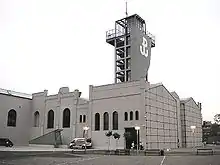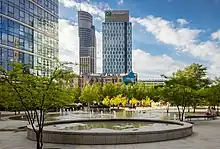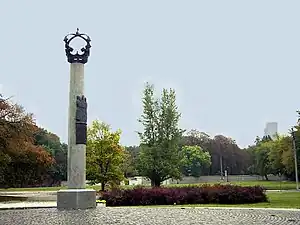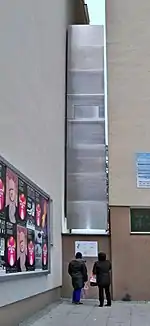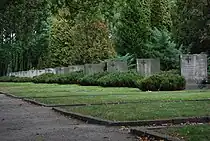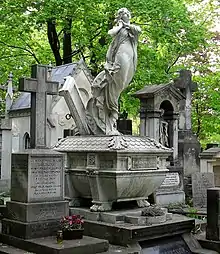Wola | |
|---|---|
 Intersection of Towarowa and Prosta streets | |
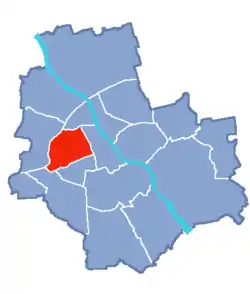 Location of Wola within Warsaw | |
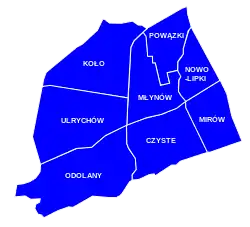 Neighbourhoods of Wola | |
| Country | |
| Voivodeship | Masovian |
| County/City | Warsaw |
| Government | |
| • Mayor | Krzysztof Strzałkowski |
| Area | |
| • Total | 19.26 km2 (7.44 sq mi) |
| Population (2019) | |
| • Total | 140,958[1] |
| Time zone | UTC+1 (CET) |
| • Summer (DST) | UTC+2 (CEST) |
| Area code | +48 22 |
| Website | wola.waw.pl |
Wola (Polish pronunciation: [ˈvɔla] ⓘ) is a district in western Warsaw, Poland. An industrial area with traditions reaching back to the early 19th century, it underwent a transformation into a major financial district, featuring various landmarks and some of the tallest office buildings in the city.
History
First mentioned in the 14th century, it became the site of the elections, from 1573 to 1764, of Polish kings by the szlachta (nobility) of the Polish–Lithuanian Commonwealth. The Wola district later became famous for the Polish Army's defence of Warsaw in 1794 during the Kościuszko Uprising and in 1831 during the November Uprising, when Józef Sowiński and Józef Bem defended the city against Tsarist forces.[2]
Until being incorporated into Warsaw in 1916, Wola was the village of Wielka Wola.[2]
During the Warsaw Uprising (August–October 1944), fierce battles raged in Wola. Around 8 August, Wola was the scene of the largest single massacre by German forces in Poland, of 40,000 to 50,000 civilians. The area was held by Polish fighters belonging to the Armia Krajowa.[3]
Wola is currently divided into the neighbourhoods of Czyste, Koło, Mirów, Młynów, Nowolipki, Odolany, Powązki and Ulrychów, which in many cases correspond to old villages or settlements.[4]
Architecture

Numerous office and residential high-rises of up to 49 stories have been built in Wola since the 1990s. Most of them are concentrated along the Towarowa and Prosta streets; these include Warsaw Spire (220 m (720 ft)), Warsaw Unit (202 m (663 ft)), Skyliner (195 m (640 ft)), Warsaw Trade Tower (187 m (614 ft)), The Warsaw Hub (130 m (430 ft) x2), Łucka City (120 m (390 ft)), Ilmet (103 m (338 ft)) and Warta Tower (82 m (269 ft)).[5]
Many other buildings rising over 100 metres (330 ft) are currently undergoing construction in Wola, such as the office skyscrapers The Bridge (174 m (571 ft)) and Skyliner II (130 m (430 ft)), the Towarowa 22 complex ((150 m (490 ft), (120 m (390 ft) and (110 m (360 ft)), and the residential Towarowa Towers (105 m (344 ft) x2).[5]
Landmarks
In the district there are several museums, the most notable being the Warsaw Uprising Museum at Towarowa Street. Wola features a public green space at Plac Europejski, where is also located a sign with the words Kocham Warszawę ("I love Warsaw"). In the district is also the Electio Viritim Monument, the art installation Keret House, and the Warsaw Insurgents and Powązki cemeteries.
Gallery
References
- ↑ "Powierzchnia i ludność w przekroju terytorialnym w 2019 roku. Tabl. 21 Powierzchnia, ludność oraz lokaty według gmi". stat.gov.pl. Główny Urząd Statystyczny. Archived from the original on 25 July 2019. Retrieved 2 September 2020.
- 1 2 "Walk around Wola district". warsawtour.pl. Retrieved 18 June 2023.
- ↑ "Wola, Warszawa, echoes of a population destroyed". Polish at heart. 23 August 2019. Archived from the original on 1 February 2023. Retrieved 18 June 2023.
- ↑ "Dzielnica Wola". Zarząd Dróg Miejskich w Warszawie (in Polish). Archived from the original on 28 November 2022. Retrieved 18 June 2023.
- 1 2 "Wola wieżowcami stoi. Dwa kolejne pną się w górę". tustolica.pl (in Polish). 10 February 2023. Retrieved 18 June 2023.
External links
- Official website

 Media related to Wola at Wikimedia Commons
Media related to Wola at Wikimedia Commons Wola travel guide from Wikivoyage
Wola travel guide from Wikivoyage
